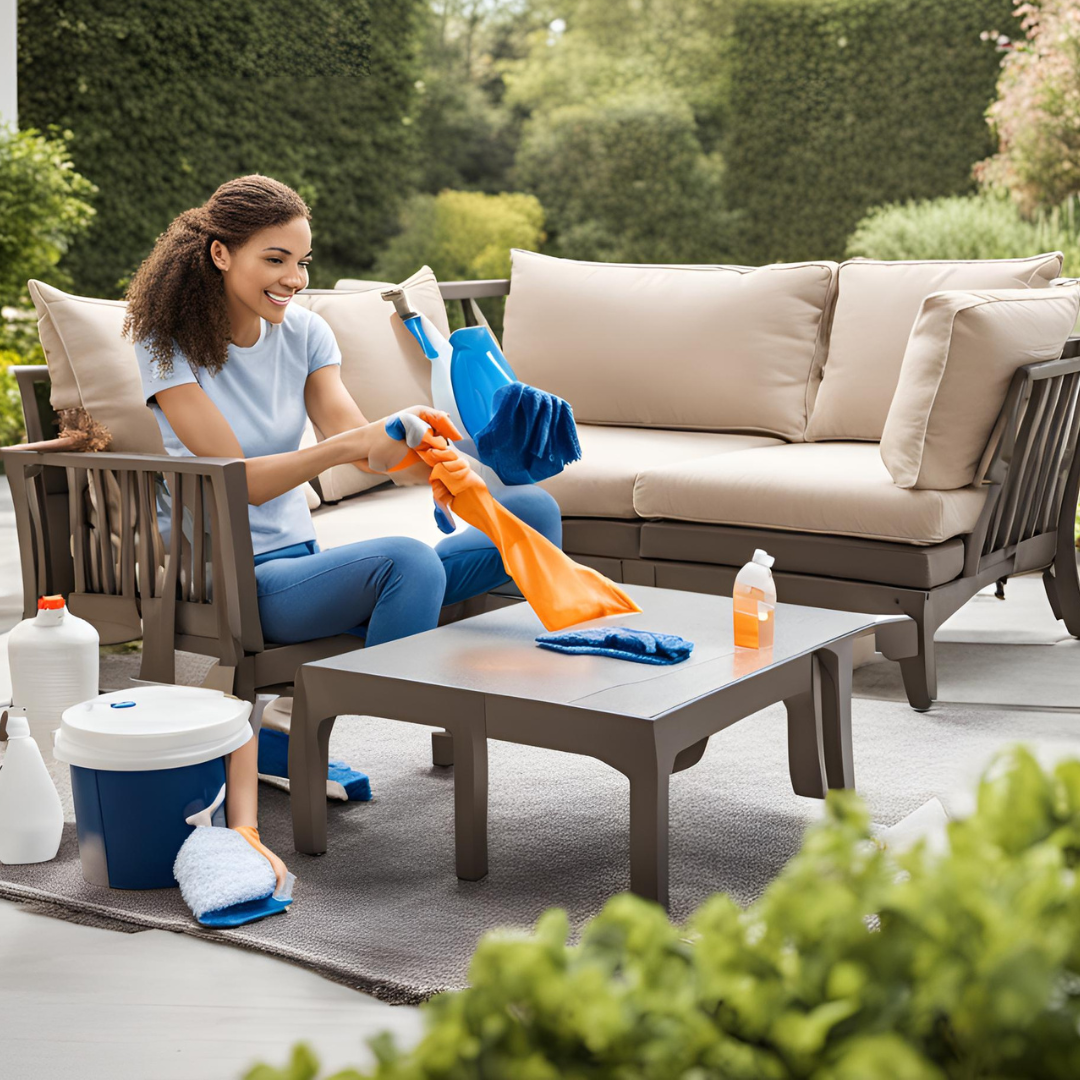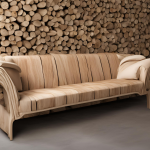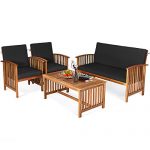
Use a mild soap solution and a soft brush to clean Patio Furniture. Rinse thoroughly with water and let it dry.
Patio furniture enhances outdoor spaces but needs regular maintenance to stay in top condition. Dirt, grime, and weather elements can take a toll on its appearance and durability. Cleaning your patio furniture properly ensures it remains inviting and extends its lifespan.
Different materials wood, metal, plastic, and fabric require specific care techniques. Understanding these differences helps you clean effectively without causing damage. Always start by checking the manufacturer’s instructions for any specific cleaning recommendations. Regular cleaning, proper storage, and routine maintenance will keep your patio furniture looking great and ready for use year-round.
Choosing The Right Cleaning Supplies
Cleaning your patio furniture can be simple and effective with the right supplies. Using the correct products and tools ensures your furniture remains in top condition. This section will help you select the best cleaning solutions and necessary tools.
Selecting The Appropriate Cleaning Solution
Each type of patio furniture requires a specific cleaning solution. Wood, metal, and plastic need different products.
Consider these guidelines:
- Wood Furniture: Use a mild soap or a specialized wood cleaner.
- Metal Furniture: A mixture of water and dish soap works well.
- Plastic Furniture: Mild detergent or a mixture of vinegar and water is effective.
Avoid harsh chemicals that can damage surfaces. Check the manufacturer’s instructions for specific recommendations.
Gathering Necessary Cleaning Tools
Having the right tools makes cleaning easier. Here’s a list of essential items for the job:
| Tool | Purpose |
|---|---|
| Soft-bristle Brush | To scrub surfaces without scratching |
| Microfiber Cloth | For wiping and drying |
| Bucket | To hold the cleaning solution |
| Garden Hose | For rinsing off dirt and soap |
Having these tools handy will make your cleaning process smooth and efficient.
Prepping The Patio Furniture
Before deep cleaning, it’s crucial to prepare your patio furniture properly. This ensures you get the best results and prevents damage. Follow these steps to make your furniture shine like new.
Removing Cushions And Fabrics
Begin by removing all cushions and fabric covers from your patio furniture. This step is essential to prevent moisture from seeping in. Use a gentle hand to avoid tearing any materials. Place the cushions and fabrics in a safe, dry area.
- Unzip and remove the cushion covers.
- Set aside pillows and throws.
- Keep all fabric items out of direct sunlight.
Dusting And Wiping Down Surfaces
After removing the cushions, focus on dusting and wiping down surfaces. Use a soft cloth or a feather duster to clear loose dirt. A microfiber cloth works best for this task.
- Start with a dry cloth to remove dust.
- Use a damp cloth for a more thorough wipe.
- Wipe down metal and plastic surfaces with a gentle cleaner.
For wooden surfaces, avoid using too much water. Moisture can warp the wood. Instead, use a damp cloth followed by a dry one to absorb any excess water.
Cleaning Tips Table
| Material | Cleaning Method |
|---|---|
| Metal | Use a mild soap and water solution. |
| Plastic | Wipe with a damp cloth and mild detergent. |
| Wood | Use a damp cloth followed by a dry one. |
| Fabric | Hand wash or use a gentle machine cycle. |
By following these steps, you ensure your patio furniture is prepped for a thorough cleaning. This helps maintain its beauty and longevity.
Cleaning Different Types Of Patio Furniture
Cleaning patio furniture keeps it looking new and extends its life. Different types of materials need different cleaning methods. Let’s explore How to Clean Dek Furniture metal, plastic, and wood.
Cleaning Metal Furniture
Metal furniture is durable but can rust. Follow these steps to keep it clean:
- Mix warm water with mild soap in a bucket.
- Dip a soft cloth or sponge into the soapy water.
- Wipe the metal surfaces thoroughly to remove dirt and grime.
- Rinse with clean water and dry with a towel.
If you see rust spots, use a metal brush to scrub them off. Then, apply a metal sealant to protect against future rust.
Cleaning Plastic Furniture
Plastic furniture is lightweight and easy to clean. Here’s how to do it:
- Make a solution of warm water and dish soap.
- Use a soft brush to scrub the plastic surfaces.
- Rinse off the soap with a garden hose or clean water.
- Dry with a soft cloth to avoid water spots.
For stubborn stains, mix baking soda and water into a paste. Apply it to the stain and scrub gently.
Cleaning Wood Furniture
Wood furniture needs special care to avoid damage. Follow these steps for cleaning:
- Use a soft brush or cloth to remove loose dirt.
- Mix mild soap with water in a bucket.
- Dip a soft cloth into the soapy water and wring it out well.
- Wipe the wood gently to clean the surface.
- Rinse with a damp cloth and dry with a towel.
For deeper cleaning, use a wood cleaner suitable for outdoor furniture. Apply a wood sealant to protect it from moisture and sun damage.
Addressing Stubborn Stains
Patio furniture often faces tough stains from food, drinks, and outdoor elements, which can be challenging to remove. Identifying the stain type and using the right techniques ensures your furniture looks new again.
Identifying Common Stains
Understanding the type of stain is the first step. Here are some common ones:
- Food and Beverage Stains: These include ketchup, mustard, wine, and coffee.
- Mold and Mildew: These appear as black or green spots, especially in humid areas.
- Rust Stains: Metal furniture or nearby items can leave rust marks.
- Tree Sap: Sticky and tough to remove, often found under trees.
Applying Stain Removal Techniques
Once you identify the stain, use the appropriate technique:
- Food and Beverage Stains: Mix a solution of mild dish soap and warm water. Use a soft brush to scrub the stain gently. Rinse with clean water and let it dry.
- Mold and Mildew: Create a mixture of one part white vinegar and one part water. Spray the solution on the stain and scrub it with a brush. Rinse thoroughly and dry in the sun.
- Rust Stains: Use a mixture of lemon juice and salt. Apply it to the rust stain and let it sit for 10 minutes. Scrub with a soft brush and rinse well.
- Tree Sap: Rub the area with rubbing alcohol using a cloth. Gently scrub to remove the sap. Rinse with water and dry.
These techniques help remove stubborn stains from your patio furniture. Always test a small area first to ensure the solution doesn’t damage the material.
Rinsing And Drying The Furniture
After scrubbing and cleaning your patio furniture, the next crucial step is rinsing and drying it. Proper rinsing ensures no cleaning residue is left behind. Allowing sufficient drying time prevents mold and mildew.
Thoroughly Rinsing Off Cleaning Residue
Use a garden hose with a gentle spray setting. Make sure to rinse every nook and cranny of the furniture. Pay extra attention to areas with intricate designs or patterns.
For metal furniture, ensure you rinse off all soap. Soap residue can cause rust or corrosion over time. For wooden furniture, rinse thoroughly but avoid soaking the wood. Excess water can damage the wood.
Plastic and resin furniture are more resilient. Ensure you rinse off all soap to avoid a sticky residue. Use a soft cloth to wipe off excess water gently.
Allowing Sufficient Drying Time
After rinsing, place the furniture in a sunny spot. Direct sunlight helps speed up the drying process. Ensure the furniture is completely dry before using it again.
For metal furniture, wipe down with a dry cloth to avoid water spots. For wooden furniture, make sure it dries thoroughly to prevent mold and mildew. Use a dry cloth to blot any remaining water.
Plastic and resin furniture dry quickly but ensure no water is trapped in crevices. If necessary, use a soft cloth to wipe down.
Here is a quick overview:
| Material | Rinsing Tips | Drying Tips |
|---|---|---|
| Metal | Rinse thoroughly to avoid rust | Wipe with a dry cloth |
| Wood | Avoid soaking, rinse well | Ensure complete drying |
| Plastic/Resin | Rinse thoroughly, and wipe off excess | Dry quickly, check crevices |
Maintaining Patio Furniture For Longevity
Keeping your patio furniture clean and well-maintained ensures it lasts for years. Regular care can prevent wear and damage. Follow these steps to keep your outdoor furniture looking new.
Regular Cleaning Schedule
Establishing a regular cleaning schedule is crucial. Dust and dirt can build up quickly. Clean your furniture at least once a month. Use a mild soap and water solution. For tougher stains, use a soft brush. Rinse thoroughly and let it dry completely.
Here’s a simple cleaning routine:
- Weekly: Wipe down surfaces with a damp cloth.
- Monthly: Wash with mild soap and water.
- Seasonal: Deep clean and inspect for damage.
Applying Protective Treatments
Applying protective treatments can extend the life of your furniture. Use a UV-protectant spray to prevent sun damage. For wooden furniture, apply a sealant. This will protect it from moisture and insects.
Consider these treatments:
- UV-protectant: Spray on plastic and metal surfaces.
- Wood sealant: Apply to wooden furniture to prevent rot.
- Rust prevention: Use a rust-resistant primer on metal pieces.
Protective covers are also a great investment. They shield your furniture from the elements. Use them during harsh weather conditions.
By following these steps, you can enjoy your patio furniture for many years. Regular care and protective treatments are key to its longevity.
Storing Patio Furniture Properly
Storing patio furniture ensures it remains in excellent condition for years to come. Proper storage can prevent damage from weather elements, pests, and dirt. Follow these steps to keep your patio furniture looking brand new.
Cleaning Before Storage
Always clean your patio furniture before storing it. Dirt and grime can cause damage over time. Here is how you can clean different types of furniture:
- Wooden Furniture: Use a mild soap solution and a soft brush. Rinse with water and let it dry completely.
- Metal Furniture: Wipe with a damp cloth and mild detergent. Dry thoroughly to prevent rust.
- Plastic Furniture: Clean with a mixture of water and mild detergent. Rinse and dry.
- Fabric Cushions: Remove covers and wash according to the manufacturer’s instructions. Air dry the cushions.
Ensuring your furniture is clean before storage prevents the buildup of mold and mildew.
Utilizing Furniture Covers
Using furniture covers offers extra protection during storage. Here are some tips for using covers effectively:
- Choose the Right Size: Ensure the cover fits your furniture snugly. A well-fitted cover provides better protection.
- Material Matters: Select covers made of durable, waterproof material. This prevents moisture from seeping in.
- Secure the Covers: Use ties or straps to secure the covers. This prevents them from blowing away in strong winds.
Properly covering your furniture shields it from dust, dirt, and weather conditions, keeping it in top shape for the next season.
Enhancing The Look Of Patio Furniture
Cleaning patio furniture is only the first step. Enhance its appearance with simple touches. These changes can transform your outdoor space into a cozy retreat. Let’s explore some effective ways to elevate the look of your patio furniture.
Accessorizing With Decorative Elements
Adding decorative elements to your patio furniture can make a big difference. Here are some ideas:
- Lanterns and Candles: Place lanterns or candles on tables. They add a warm, inviting glow.
- Planters and Pots: Use colorful planters and pots. Fill them with vibrant flowers or lush greenery.
- Outdoor Rugs: Lay down an outdoor rug. It ties the area together and adds comfort underfoot.
These small touches can create a more inviting and stylish outdoor space.
Adding Comfort With Cushions And Pillows
Comfort is key for any seating area. Adding cushions and pillows can make your patio furniture more enjoyable.
- Choose Weather-Resistant Fabrics: Pick cushions made from weather-resistant fabrics. They withstand sun, rain, and dirt.
- Mix and Match Colors: Use a mix of colors and patterns. It adds visual interest and charm.
- Ensure Easy Maintenance: Opt for removable covers. They make cleaning easier.
These additions not only enhance comfort but also boost the visual appeal of your patio furniture.
Frequently Asked Questions
What’s The Best Thing To Clean Patio Furniture With?
Use a mixture of mild soap and water to clean patio furniture. For tough stains, use white vinegar or baking soda. Always rinse thoroughly and dry.
Can You Use Dawn To Clean Outdoor Furniture?
Yes, you can use Dawn to clean outdoor furniture. Mix Dawn with water, scrub gently, and rinse thoroughly.
How Do You Clean Fabric On Outdoor Furniture?
Use mild soap and warm water. Scrub gently with a soft brush. Rinse thoroughly and let it air dry. For tough stains, use a fabric cleaner—store cushions when not in use.
How Do I Make My Patio Furniture Look New?
Clean with mild soap and water. Remove rust or stains with a vinegar solution. Repaint or re-stain wood. Replace worn cushions. Use furniture covers when not in use.
Are you looking for Wooden Patio Furniture?
Transform your outdoor space into a cozy retreat. Elevate your patio with stylish and comfortable, and provide a relaxing outdoor living experience. Whether hosting a summer BBQ, enjoying a quiet morning coffee, or simply unwinding after a long day, the right Patio Furniture can make all the difference in creating a welcoming outdoor oasis.
What is the best solution for cleaning outdoor furniture?
When it comes to maintaining your outdoor space, finding the right cleaning method is crucial. So, what is the best solution for cleaning outdoor furniture? Whether you have wooden, metal, or plastic furniture, the right cleaning solution can enhance the longevity and appearance of your outdoor seating and dining areas. We’ll explore effective techniques and products that will help you restore your outdoor furniture to its former glory, ensuring a welcoming environment for family and friends.
Can you use vinegar to clean patio furniture?
Are you looking for a natural and effective solution for maintaining your outdoor space? This versatile household item is great for cooking and serves as an excellent cleaning agent, especially for patio furniture.
In this article, we will explore the benefits of vinegar, the best methods to clean your furniture, and tips to ensure that your outdoor seating remains in top condition. Whether you have plastic, metal, or wooden furniture, vinegar can help you achieve a sparkling clean finish while being environmentally friendly.
Conclusion
Keeping your patio furniture clean enhances its lifespan and appearance. Regular maintenance prevents damage and the buildup of dirt. Use the tips mentioned to keep your outdoor space inviting. Enjoy a clean and comfortable patio all year round. Happy cleaning!








